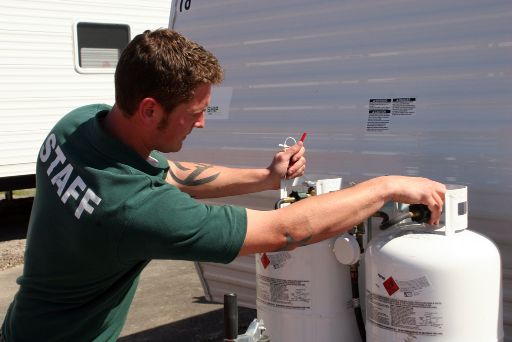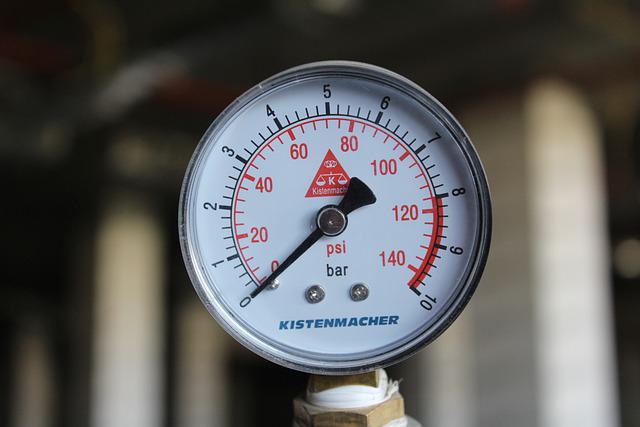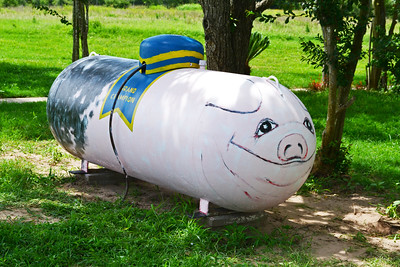
Here are some of the ways you can do to transport a 100lb propane tank:
- Use a hand truck or dolly: Place the propane tank on the hand truck or dolly and carefully roll it to its destination.
- Use a pickup truck or trailer: Secure the propane tank in the bed of the pickup truck or trailer using straps or bungee cords. Make sure the tank is secured properly and will not move during transport.
- Use a propane tank trailer: There are specialized trailers available for transporting propane tanks. These trailers are designed to safely transport propane tanks of various sizes.
Assuming you have a properly secured 100lb propane tank in a vehicle:
The first thing you want to do is make sure the tank is in an upright position. This will help prevent any leaks from happening during transport. If the tank is not in an upright position, it is important to secure it so it cannot tip over.
Next, you want to check the valves and regulator on the tank to ensure they are closed. This will help prevent any propane from leaking out.
Once the tank is in an upright position and the valves are closed, you can begin to transport it. It is important to keep the tank away from any sources of heat or flame, as this can cause the propane to ignite. If possible, you should also avoid bumping or jarring the tank, as this can also cause a leak.
To learn more about transporting 100-lb tank on your vehicle, read below.
[table id=3 /]
Getting to Know Your 100lb Propane Tank
Size and What’s Inside
You might be wondering just how big a 100lb propane tank is:
- Height: Think of it as roughly the size of a tall bar stool, about 48 inches tall.
- Diameter: It’s about 14.5 inches wide, similar to the size of a car tire.
- Weight: When full, it’ll weigh between 170 to 180 pounds. On its own, without propane, it’s around 70-80 pounds and It is even heavier when filled.
- Capacity: You’ve got about 23.6 gallons of liquid propane in there.
Key Features to Notice
Your propane tank isn’t just a big steel container. It’s got some neat features:
- Material: It’s made of tough steel that doesn’t rust easily.
- Valve: There’s a main valve on top. It also has a special feature to stop overfilling, making sure there’s space left inside for propane to expand if it gets warm.
- Protective Bits: Check out the collar around the valve. It’s like a shield. The foot ring at the bottom? That’s to keep your tank from rolling around.
- Safety Features: There’s a safety relief valve too. If things get too pressurized inside, it’ll release some propane so the tank doesn’t burst.
Why You Should Care About Safety
This isn’t just any tank; it’s a big one with flammable stuff inside. Here’s why you should handle it with care:
- It’s Flammable: Propane catches fire easily. Make sure there are no leaks and keep it away from anything that sparks or flames.
- It’s Heavy: A full tank can hurt you if it falls. Always keep it upright and stable.
- It’s Pressurized: Remember, this tank is filled with pressurized gas. Treat it nicely to avoid any dangerous releases.
- Weather Matters: On super hot days, the tank pressure might go up. Keep it somewhere not too hot or cold.
- Avoid Overfilling: Even though there’s a feature to prevent overfilling, always be cautious. Don’t try to cram in more propane than it’s designed for.
Understanding your 100lb propane tank is the first step to using it safely and efficiently. Always treat it with respect and care!
Getting Your 100lb Propane Tank Ready for Transport
1. Look it Over
Before anything else, give your tank a good once-over:
- Visible Damages: Check for any dents, rust, or wear and tear. If you see major damage, it might be best to reconsider transporting it.
2. Valve Check
This is a crucial step:
- Close it Up: Make sure the main valve on your tank is turned off completely. Turning it clockwise should do the trick.
- Cap On: Once it’s closed, ensure that the protective cap is in place. This helps prevent any accidental releases or leaks.
3. Disconnect Everything
You want your tank to be stand-alone for transport:
- Loose Ends: Make sure there are no hoses, attachments, or connectors dangling or attached to your tank.
- Seal It Off: If you had any connections, make sure they’re tightly sealed. You don’t want any gas escaping during transport.
4. Grab Your Gear
Depending on your vehicle and journey, you might need some gear to secure your tank:
- Straps: Ratchet straps or strong bungee cords can keep your tank from rolling or moving.
- Padding: Think about using padding or cushions, especially if you’re transporting more than one tank. This prevents them from clanging together.
With these steps in mind, you’ll have your propane tank prepped and ready for a safe journey. Always remember, the key is to be thorough and careful. The better you prepare, the smoother your transport will go!
Can You Transport a 100-lb Propane Tank on Its Side?
Choosing the Right Vehicle
1. Know Your Options
Transporting a propane tank isn’t a job for just any vehicle. Here’s what’s best:
- Pickup Trucks: These are the gold standard. They offer an open-air environment, making it safer for transporting propane.
- Trailers: If hitched to your vehicle, trailers can provide a flat and stable surface for your tank.
- SUVs with Openable Rear Windows: Only if you can keep the rear window open for ventilation, and there’s enough space.
- Vans with Good Ventilation: If you absolutely must use a van, ensure it’s well-ventilated and the tank remains upright.
2. Space and Surface Matters
You can’t just shove the tank in and hope for the best:
- Adequate Space: Ensure there’s enough room so the tank isn’t squeezed or pressured. Remember, it’s about 48 inches tall.
- Flat Surface: The tank needs to sit on a flat surface. You don’t want it rolling around during the drive.
3. The Great Outdoors
Open-air transport has its benefits:
- Safety First: In the rare case of a leak, the propane disperses into the open air rather than accumulating in an enclosed space, which can be dangerous.
- Better for the Tank: Exposure to direct sunlight for prolonged periods isn’t great, but short trips in open vehicles are generally better than closed ones.
When you’re transporting a 100lb propane tank, your vehicle choice matters. Think safety and stability first. Opt for open-air transport when possible, and always ensure your tank is secure and upright. Safe travels!
How to Transport a Propane Tank on a Trailer
In order to transport a tank on a trailer, you will need to follow these steps:
- Make sure that the tank is in a secure and upright position. This will ensure that it doesn’t tip over during transport.
- Use straps or ratchet tie-downs to secure the tank to the trailer. This will prevent it from moving around during transit.
- Cover the tank with a tarp or other protective material. This will help to keep it clean and free from debris.
- Make sure that the tank is properly vented. This will allow for the safe release of any pressure that may build up inside the tank during transport.
- Check the tank regularly during transport to ensure that it remains secure and upright. This will help to avoid any accidents or damage to the tank.
How to Transport a Propane Tank on a Bicycle
Assuming you’re asking how to safely transport a much lighter tank on a bicycle, here are a few tips:
- Firstly, make sure the tank is properly secured to the bicycle so it doesn’t fall off or tip over.
- Secondly, avoid bumps and potholes as much as possible to prevent the tank from being damaged or dislodged.
- Thirdly, keep an eye on the gauge to make sure there is enough propane left in the tank.
- Lastly, be aware of your surroundings and take extra care when biking near cars or in traffic.
Take note: local and federal laws apply when transporting tanks
You need to consider the local law in the state where you are located. Different state has its own law with regard to this. In California, for example, you cannot transport a propane tank on its side. Other states may allow this but not in this particular state.
DOT has its own requirements as well with regard to the transportation of flammable liquid. DOT specified that training of personnel in the handling of hazardous chemicals must be given, and MSDS must be provided. Proper labeling “Flammable Liquid” must be attached.
Understanding the Regulations
1. Navigating Regulations
Transporting propane isn’t just about securing the tank in your vehicle:
- Hazardous Materials Rules: Propane is classified as a hazardous material. The U.S. Department of Transportation (and similar entities in other countries) has guidelines on how much propane you can transport and under what conditions.
2. State or Local Laws
Rules can vary depending on where you are:
- Specific Guidelines: Some states or municipalities might have stricter rules on transporting propane tanks, especially large ones. It’s always a good idea to check local laws or guidelines before heading out.
3. Necessary Paperwork
In some cases, there might be extra steps:
- Permits: Depending on the quantity of propane and the purpose (commercial vs. personal use), you might need a special permit to transport a propane tank.
- Notifications: For larger quantities or commercial transport, you might be required to notify local authorities about your cargo and route.
After the Drive: Unloading and Storing Your Propane Tank
1. Safe Unloading Spots
Picking the right place to unload is as vital as the transport:
- Away from Ignition Sources: Ensure the unloading area is free from open flames or anything that could ignite the propane.
- Stable Ground: A flat, stable surface is essential to prevent the tank from rolling or falling.
2. Lifting and Handling
100lb propane tanks are heavy, and you need to be careful:
- Lift with Your Legs: Just like with heavy boxes, bend your knees and lift with your legs, not your back.
- Get Help: It’s a good idea to have a second person assist you, especially if you’re not used to handling heavy objects.
3. Storing Right
Once unloaded, storage is key to maintaining your tank’s condition:
- Upright Position: Always store your tank in an upright position.
- Away from Extremes: Avoid places with direct sunlight or where temperatures can drop too low. A shaded, well-ventilated area is ideal.
- Off the Ground: If possible, keep it elevated on wooden planks or a platform, especially in damp areas, to avoid rusting.
Whether you’re on the road or have reached your destination, always prioritize safety and follow regulations when handling your 100lb propane tank. By being informed and careful, you ensure a smooth process from start to finish.
To make a conclusion
Handling and transporting a 100lb propane tank is no small task. It requires meticulous attention to detail, awareness of safety protocols, and respect for the potential risks involved. While it might seem like a straightforward process, the size and nature of the content of these tanks demand your utmost caution.
Always prioritize safety over convenience. It’s better to spend a few extra minutes double-checking connections, securing the tank properly, or reviewing regulations than to rush and risk accidents. And remember, propane is not just heavy—it’s flammable and pressurized, making careful handling non-negotiable.
If, at any point, you feel uncertain about transporting your propane tank, there’s no harm in seeking out professional assistance or advice. Experts in the field can provide guidance, ensuring that you, your vehicle, and your propane tank all arrive safely at your destination.

Mike is an experienced propane technician with over 15 years of professional experience in the field. He has dedicated his career to helping customers with their propane needs, from installation to maintenance and repair. Together with Jeremy, he co-founded this website to provide useful information and guidance to customers seeking reliable propane services.




